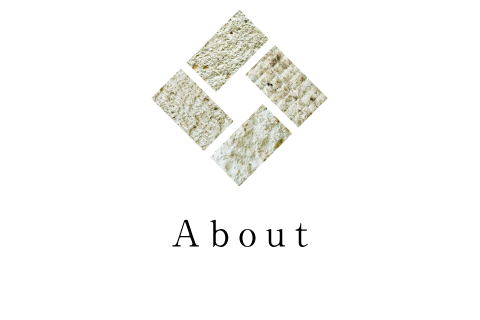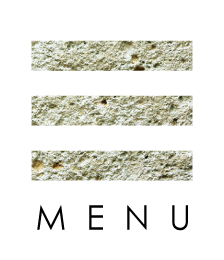
Introduction
Oya stone is dispersed in an area approximately 4km east and west and 6km north and south, mainly in Oya Town (former Shiroyama Village Arahari) located approximately 8km from the center of Utsunomiya City, Tochigi Prefecture. This stone has the common name “Oya stone,” as it is produced in Oyama Town, but the geological and petrological name is “Rhyolite welded tuff,” which is a type of tuff. There are multiple other locations domestically in which various tuff is mined, but all are of extremely small scale. Oya is a very rare location, without many similar examples worldwide, where mining that began long ago is still continuing in large scale today. The reserves are estimated to be approximately 600 million tons, located in about 200 mining locations (including unused mines). Of those, 6 locations are presently in operation, annually shipping approximately 10,000 tons of Oya stone. Open-pit mining is being conducted at some of the locations as well, but the majority is underground mining. Underground mining is conducted at the bottom of deep mining pits, several 10’s – 100 meters or more below ground.
The History of Oya Stone Use
The oldest record of Oya stone being used is in the Mibu Town Kurumadsuka Tombs and Mamada Town Sendadsuka area Hyakudsuka. An Oya stone sarcophagus from approximately 1,500 years ago has been excavated.
795
Used in the foundation of the Kokubunji (Buddhist temples) in year 13 of the Tenpyo era (795).
1063
Used by an ancestor of Utsunomiya, Soen, in the construction of Utsunomiya Castle in the year 6 of the Kohei era (1063) of the 70th emperor of Japan, Emperor Go-Reizei.
1375
Used in the establishment of the Oya stone Gorinto (five-ringed tower) in the Kozenji precincts in Utsunomiya City in the Eiwa era.
1620
Used in castle building in year 6 of the Genwa era (1620), by castle owner Masazumi Honda who collected Oya stone from the Tano Village.
(In 1933, an underpass of Oya stone was excavated at the site of the former Honmaru of the castle.)
1721
Exported to Edo by raft, using the Kinu River water supply in year 6 of the Kyoho era (1721). At that time there were 6 wholesalers that handled Oya stone along the Sumida River in Edo. There are dock usage theories from the Kinu River of Ishii Town and from the Sumida River of Makuta Town.
1785
Used in large quantity when restoring the stone wall of the Utsunomiya Futaarayama Shrine in year 3 of the Koka era (1785).
【Meiji era】Starting in the Meiji era, beginning with Tokyo, a sales network throughout the Kanto region spread along with the development of transportation.
1922
In year 11 of the Taisho era (1922), the Old Imperial Hotel was constructed using Oya stone according to the American architect Wright’s design. In September of year 12 of the Taisho era (1923), the Great Kanto Earthquake occurred. The Imperial Hotel remained unburned, and proved its superior fire-proof capability, thus increasing its reputation. (A portion of the Old Imperial Hotel has been relocated and is presently being stored in Meiji Village in Inuyama City, Aichi Prefecture.)
Oya Stone Transport
From the Edo era to the start of the Meiji era, Oya stone was transported on the backs of horses. One stone (15×30×90cm) was placed at a time on the right and left sides of a horse) in addition to transport by boat. Since the opening of the “Utsunomiya Railway Transport Co., Ltd.,” a change was made to transporting by railroad tracks. The “Utsunomiya Railway Transport Co., Ltd.,” underwent an absorption merger with the “Tobu Railway Co., Ltd.” in year 6 of the Showa era (1931), and a full-scale railway transport age began. After going through the transportation revolution age, the railways to transport Oya stone were completely discontinued in year 36 of the Showa era (1961). A portion of the long-distance freight car transport was left in place, as a change was made the present-day transportation format mainly utilizing trucks.
The Mechanization of Oya Stone Mining
During the war there were efforts made to mechanize Oya stone mining with the idea of an agricultural cultivator, but it was not successful. In year 27 of the Show era (1952), the Mechanization Research Committee was established in the Oya Stone Cooperative. In year 29 of the Showa era (1954), a union processing plant was established by a prefectural subsidy. Two cutting machines were installed to cosmetically cut Oya stone into sheets. In year 30 of the Showa era (1955), a chain-type mining machine prototype was also successfully created, and with various improvements made thereafter, all quarries were mechanized around year 34 of the Show era (1959). The cutting machines were also able to be combined into one unit with the cosmetic cutting machines. This success was realized by coincidence from the inspiration of the chain of a quarry machine that was ordered from France.
